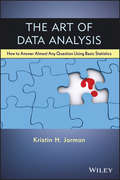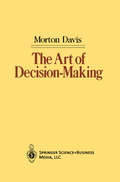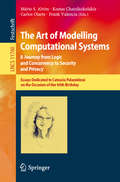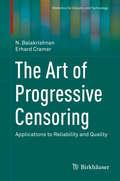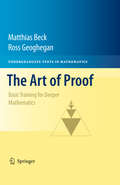- Table View
- List View
The Art of Data Analysis: How to Answer Almost Any Question Using Basic Statistics
by Kristin H. JarmanA friendly and accessible approach to applying statistics in the real world With an emphasis on critical thinking, The Art of Data Analysis: How to Answer Almost Any Question Using Basic Statistics presents fun and unique examples, guides readers through the entire data collection and analysis process, and introduces basic statistical concepts along the way. Leaving proofs and complicated mathematics behind, the author portrays the more engaging side of statistics and emphasizes its role as a problem-solving tool. In addition, light-hearted case studies illustrate the application of statistics to real data analyses, highlighting the strengths and weaknesses of commonly used techniques. Written for the growing academic and industrial population that uses statistics in everyday life, The Art of Data Analysis: How to Answer Almost Any Question Using Basic Statistics highlights important issues that often arise when collecting and sifting through data. Featured concepts include: • Descriptive statistics • Analysis of variance • Probability and sample distributions • Confidence intervals • Hypothesis tests • Regression • Statistical correlation • Data collection • Statistical analysis with graphs Fun and inviting from beginning to end, The Art of Data Analysis is an ideal book for students as well as managers and researchers in industry, medicine, or government who face statistical questions and are in need of an intuitive understanding of basic statistical reasoning.
The Art of Decision-Making
by Morton DavisSuppose you had the chance to invest in a venture that succeeds half the time. When you fail you lose your in vestment; when you succeed you make a profit of$1.60 for every $1.00 you invest. The odds are 8 to 5 in your favor and you should do well-casinos and insurance companies thrive under less favorable conditions. If you can invest as much as you like, as often as you like, using a betting system that guarantees you can't go broke, common sense suggests you will almost certainly make aprofitafteryou make a large numberofinvestments. In response to yourrequest for a hot stock yourastrologer tells you ABC Inc. will triple in a year (she's really a fraud and picked the stock at random). But since such stocks are rare (one in athousand) you consultan expert and, strangely enough, he confirms the astrologer. From experience you know that the expert diagnoses all stocks, good and bad, correctly, 90% of the time. Common sense suggests you have an excellent chance of tripling your money. You are chairman of acommittee ofthree. Decisions are made by majority rule but if there is no majority your vote as chairman breaks ties. Common sense suggests you will inevitably have more power to determine the outcome than the other members.
The Art of Doing Algebraic Geometry (Trends In Mathematics Ser.)
by Thomas Dedieu Flaminio Flamini Claudio Fontanari Concettina Galati Rita PardiniThe Art of Finding Hidden Risks: Hidden Regular Variation in the 21st Century
by Sidney ResnickThis text gives a comprehensive, largely self-contained treatment of multivariate heavy tail analysis. Emphasizing regular variation of measures means theory can be presented systematically and without regard to dimension. Tools are developed that allow a flexible definition of "extreme" in higher dimensions and permit different heavy tails to coexist on the same state space leading to "hidden regular variation" and "steroidal regular variation". This emphasizes when estimating risks, it is important to choose the appropriate heavy tail. Theoretical foundations lead naturally to statistical techniques; examples are drawn from risk estimation, finance, climatology and network analysis. Treatments target a broad audience in insurance, finance, data analysis, network science and probability modeling. The prerequisites are modest knowledge of analysis and familiarity with the definition of a measure; regular variation of functions is reviewed but is not a focal point.
The Art of Gluing Space-Time Manifolds: Methods and Applications (SpringerBriefs in Physics)
by Samad Khakshournia Reza MansouriThis concise book reviews methods used for gluing space-time manifolds together. It is therefore relevant to theorists working on branes, walls, domain walls, concepts frequently used in theoretical cosmology, astrophysics, and gravity theory. Nowadays, applications are also in theoretical condensed matter physics where Riemannian geometry appears. The book also reviews the history of matching conditions between two space-time manifolds from the early times of general relativity up to now.
The Art of Modeling Mechanical Systems (CISM International Centre for Mechanical Sciences #570)
by Friedrich Pfeiffer Hartmut BremerThe papers in this volume present rules for mechanical models in a general systematic way, always in combination with small and large examples, many from industry, illustrating the most important features of modeling. The best way to reach a good solution is discussed. The papers address researchers and engineers from academia and from industry, doctoral students and postdocs, working in the fields of mechanical, civil and electrical engineering as well as in fields like applied physics or applied mathematics.
The Art of Modelling Computational Systems: Essays Dedicated to Catuscia Palamidessi on the Occasion of Her 60th Birthday (Lecture Notes in Computer Science #11760)
by Mário S. Alvim Kostas Chatzikokolakis Carlos Olarte Frank ValenciaThis Festschrift was published in honor of Catuscia Palamidessi on the occasion of her 60th birthday.It features 6 laudations, which are available in the front matter of the volume, and 25 papers by close collaborators and friends. The papers are organized in topical sections named: concurrency; logic and constraint programming; security and privacy; and models and puzzles.These contributions are a tribute to Catuscia Palamidessi’s intellectual depth, vision, passion for science, and tenacity in solving technical problems. They also reflect the breadth and impact of her work. Her scientific interests include, in chronological order, principles of programming languages, concurrency theory, security, and privacy.
The Art of Modelling the Learning Process: Uniting Educational Research and Practice (Springer Texts in Education)
by Jimmie LeppinkBy uniting key concepts and methods from education, psychology, statistics, econometrics, medicine, language, and forensic science, this textbook provides an interdisciplinary methodological approach to study human learning processes longitudinally. This longitudinal approach can help to acquire a better understanding of learning processes, can inform both future learning and the revision of educational content and formats, and may help to foster self-regulated learning skills. The initial section of this textbook focuses on different types of research questions as well as practice-driven questions that may refer to groups or to individual learners. This is followed by a discussion of different types of outcome variables in educational research and practice, such as pass/fail and other dichotomies, multi-category nominal choices, ordered performance categories, and different types of quantifiable (i.e., interval or ratio level of measurement) variables. For each of these types of outcome variables, single-measurement and repeated-measurements scenarios are offered with clear examples. The book then introduces cross-sectional and longitudinal interdependence of learning-related variables through emerging network-analytic methods and in the final part the learned concepts are applied to different types of studies involving time series. The book concludes with some general guidelines to give direction to future (united) educational research and practice. This textbook is a must-have for all applied researchers, teachers and practitioners interested in (the teaching of) human learning, instructional design, assessment, life-long learning or applications of concepts and methods commonly encountered in fields such as econometrics, psychology, and sociology to educational research and practice.
The Art Of Modern Php 8 (PDF): Your Practical And Essential Guide To Getting Up To Date With Php 8
by Joseph Edmonds Lorna Jane MitchellDiscover how to apply the principles of OOP, types, and package management the right way Key Features Explore the latest PHP 8.1 features and modern web development practices Refactor your legacy codebase using modern features and styles in PHP Create your own Composer packages that can be reused across all PHP projects Book Description PHP has come a long way since its introduction. While the language has evolved with PHP 8, there are still a lot of websites running on a version of PHP that is no longer supported. If you are a PHP developer working with legacy PHP systems and want to discover the tenants of modern PHP, this is the book for you. The Art of Modern PHP 8 walks you through the latest PHP features and language concepts. The book helps you upgrade your knowledge of PHP programming and practices. Starting with object-oriented programming (OOP) in PHP and related language features, you'll work through modern programming techniques such as inheritance, understand how it contrasts with composition, and finally look at more advanced language features. You'll learn about the MVC pattern by developing your own MVC system and advance to understanding what a DI container does by building a toy DI container. The book gives you an overview of Composer and how to use it to create reusable PHP packages. You'll also find techniques for deploying these packages to package libraries for other developers to explore. By the end of this PHP book, you'll have equipped yourself with modern server-side programming techniques using the latest versions of PHP. What you will learn Understand how to use modern PHP features such as objects, types, and more Get to grips with PHP package management using Composer Explore dependency injection for your PHP applications Find out what the differences are between legacy and modern PHP 8 code and practices Write clean PHP code and implement design patterns Get hands-on with modern PHP using examples applying MVC and DI techniques Who this book is for The book is for existing PHP developers and CTO-level professionals who are working with PHP technologies, including legacy PHP, in production. The book assumes beginner-level knowledge of PHP programming as well as experience with server-side development.
The Art Of Probability
by Richard W. HammingOffering accessible and nuanced coverage, Richard W. Hamming discusses theories of probability with unique clarity and depth. Topics covered include the basic philosophical assumptions, the nature of stochastic methods, and Shannon entropy. One of the best introductions to the topic, The Art of Probability is filled with unique insights and tricks worth knowing.
The Art Of Probability: For Scientists And Engineers
by Richard W. HammingOffering accessible and nuanced coverage, Richard W. Hamming discusses theories of probability with unique clarity and depth. Topics covered include the basic philosophical assumptions, the nature of stochastic methods, and Shannon entropy. One of the best introductions to the topic, The Art of Probability is filled with unique insights and tricks worth knowing.
The Art of Problem Posing
by Stephen I. Brown Marion I. WalterThe new edition of this classic book describes and provides a myriad of examples of the relationships between problem posing and problem solving, and explores the educational potential of integrating these two activities in classrooms at all levels. The Art of Problem Posing, Third Edition encourages readers to shift their thinking about problem posing (such as where problems come from, what to do with them, and the like) from the "other" to themselves and offers a broader conception of what can be done with problems. Special features include: an exploration of the logical relationship between problem posing and problem solving; sketches, drawings, and diagrams that illustrate the schemes proposed; and a special section on writing in mathematics.In the updated third edition, the authors specifically:*address the role of problem posing in the NCTM Standards;*elaborate on the concept of student as author and critic;*include discussion of computer applications to illustrate the potential of technology to enhance problem posing in the classroom;*expand the section on diversity/multiculturalism; and*broaden discussion of writing as a classroom enterprise.This book offers present and future teachers at the middle school, secondary school, and higher education levels ideas to enrich their teaching and suggestions for how to incorporate problem posing into a standard mathematics curriculum.
The Art of Problem Posing
by Stephen I. Brown Marion I. WalterThe new edition of this classic book describes and provides a myriad of examples of the relationships between problem posing and problem solving, and explores the educational potential of integrating these two activities in classrooms at all levels. The Art of Problem Posing, Third Edition encourages readers to shift their thinking about problem posing (such as where problems come from, what to do with them, and the like) from the "other" to themselves and offers a broader conception of what can be done with problems. Special features include: an exploration of the logical relationship between problem posing and problem solving; sketches, drawings, and diagrams that illustrate the schemes proposed; and a special section on writing in mathematics.In the updated third edition, the authors specifically:*address the role of problem posing in the NCTM Standards;*elaborate on the concept of student as author and critic;*include discussion of computer applications to illustrate the potential of technology to enhance problem posing in the classroom;*expand the section on diversity/multiculturalism; and*broaden discussion of writing as a classroom enterprise.This book offers present and future teachers at the middle school, secondary school, and higher education levels ideas to enrich their teaching and suggestions for how to incorporate problem posing into a standard mathematics curriculum.
The Art of Progressive Censoring: Applications to Reliability and Quality (Statistics for Industry and Technology)
by N. Balakrishnan Erhard CramerThis book offers a thorough and updated guide to the theory and methods of progressive censoring, an area that has experienced tremendous growth over the last decade. The theory has developed quite nicely in some special cases having practical applications to reliability and quality. The Art of Progressive Censoring is a valuable reference for graduate students, researchers, and practitioners in applied statistics, quality control, life testing, and reliability. With its accessible style and concrete examples, the work may also be used as a textbook in an advanced undergraduate or a beginning graduate course on censoring or progressive censoring, as well as a supplementary textbook for a course on ordered data.
The Art of Proof: Basic Training for Deeper Mathematics (Undergraduate Texts in Mathematics)
by Matthias Beck Ross GeogheganThe Art of Proof is designed for a one-semester or two-quarter course. A typical student will have studied calculus (perhaps also linear algebra) with reasonable success. With an artful mixture of chatty style and interesting examples, the student's previous intuitive knowledge is placed on solid intellectual ground. The topics covered include: integers, induction, algorithms, real numbers, rational numbers, modular arithmetic, limits, and uncountable sets. Methods, such as axiom, theorem and proof, are taught while discussing the mathematics rather than in abstract isolation. The book ends with short essays on further topics suitable for seminar-style presentation by small teams of students, either in class or in a mathematics club setting. These include: continuity, cryptography, groups, complex numbers, ordinal number, and generating functions.
The Art of Proving Binomial Identities (Discrete Mathematics and Its Applications)
by Michael Z. SpiveyThe Art of Proving Binomial Identities accomplishes two goals: (1) It provides a unified treatment of the binomial coefficients, and (2) Brings together much of the undergraduate mathematics curriculum via one theme (the binomial coefficients). The binomial coefficients arise in a variety of areas of mathematics: combinatorics, of course, but also basic algebra (binomial theorem), infinite series (Newton’s binomial series), differentiation (Leibniz’s generalized product rule), special functions (the beta and gamma functions), probability, statistics, number theory, finite difference calculus, algorithm analysis, and even statistical mechanics. The book is very suitable for advanced undergraduates or beginning graduate students and includes various exercises asking them to prove identities. Students will find that the text and notes at the end of the chapters encourages them to look at binomial coefficients from different angles. With this learning experience, students will be able to understand binomial coefficients in a new way. Features: Provides a unified treatment of many of the techniques for proving binomial coefficient identities. Ties together several of the courses in the undergraduate mathematics curriculum via a single theme. A textbook for a capstone or senior seminar course in mathematics. Contains several results by the author on proof techniques for binomial coefficients that are not well-known. Ideal for self-study, it contains a large number of exercises at the end of each chapter, with hints or solutions for every exercise at the end of the book.
The Art of Proving Binomial Identities (Discrete Mathematics and Its Applications)
by Michael Z. SpiveyThe Art of Proving Binomial Identities accomplishes two goals: (1) It provides a unified treatment of the binomial coefficients, and (2) Brings together much of the undergraduate mathematics curriculum via one theme (the binomial coefficients). The binomial coefficients arise in a variety of areas of mathematics: combinatorics, of course, but also basic algebra (binomial theorem), infinite series (Newton’s binomial series), differentiation (Leibniz’s generalized product rule), special functions (the beta and gamma functions), probability, statistics, number theory, finite difference calculus, algorithm analysis, and even statistical mechanics. The book is very suitable for advanced undergraduates or beginning graduate students and includes various exercises asking them to prove identities. Students will find that the text and notes at the end of the chapters encourages them to look at binomial coefficients from different angles. With this learning experience, students will be able to understand binomial coefficients in a new way. Features: Provides a unified treatment of many of the techniques for proving binomial coefficient identities. Ties together several of the courses in the undergraduate mathematics curriculum via a single theme. A textbook for a capstone or senior seminar course in mathematics. Contains several results by the author on proof techniques for binomial coefficients that are not well-known. Ideal for self-study, it contains a large number of exercises at the end of each chapter, with hints or solutions for every exercise at the end of the book.
The Art of Quantitative Finance Vol.1: Trading, Derivatives and Basic Concepts (Springer Texts in Business and Economics)
by Gerhard LarcherThis textbook offers an easily understandable introduction to the fundamental concepts of financial mathematics and financial engineering. The author presents and discusses the basic concepts of financial engineering and illustrates how to trade and to analyze financial products with numerous examples. Special attention is given to the valuation of basic financial derivatives. In the final section of the book, the author introduces the Wiener Stock Price Model and the basic principles of Black-Scholes theory. The book’s aim is to introduce readers to the basic techniques of modern financial mathematics in a way that is intuitive and easy to follow, and to provide financial mathematicians with insights into practical requirements when applying financial mathematical techniques in the real world.
The Art of Quantitative Finance Vol.2: Volatilities, Stochastic Analysis and Valuation Tools (Springer Texts in Business and Economics)
by Gerhard LarcherThis textbook provides the necessary techniques from financial mathematics and stochastic analysis for the valuation of more complex financial products and strategies. The author discusses how to make use of mathematical methods to analyse volatilities in capital markets. Furthermore, he illustrates how to apply and extend the Black-Scholes theory to several fields in finance. In the final section of the book, the author introduces the readers to the fundamentals of stochastic analysis and presents examples of applications. This book builds on the previous volume of the author’s trilogy on quantitative finance. The aim of the second volume is to present and discuss more complex and advanced techniques of modern financial mathematics in a way that is intuitive and easy to follow. As in the previous volume, the author provides financial mathematicians with insights into practical requirements when applying financial mathematical techniques in the real world.
The Art of Random Walks (Lecture Notes in Mathematics #1885)
by Andras TelcsThe main aim of this book is to reveal connections between the physical and geometric properties of space and diffusion. This is done in the context of random walks in the absence of algebraic structure, local or global spatial symmetry or self-similarity. The author studies heat diffusion at this general level and discusses the multiplicative Einstein relation; Isoperimetric inequalities; and Heat kernel estimates; Elliptic and parabolic Harnack inequality.
The Art of Regression Modeling in Road Safety
by Ezra HauerThis unique book explains how to fashion useful regression models from commonly available data to erect models essential for evidence-based road safety management and research. Composed from techniques and best practices presented over many years of lectures and workshops, The Art of Regression Modeling in Road Safety illustrates that fruitful modeling cannot be done without substantive knowledge about the modeled phenomenon. Class-tested in courses and workshops across North America, the book is ideal for professionals, researchers, university professors, and graduate students with an interest in, or responsibilities related to, road safety.This book also:· Presents for the first time a powerful analytical tool for road safety researchers and practitioners· Includes problems and solutions in each chapter as well as data and spreadsheets for running models and PowerPoint presentation slides· Features pedagogy well-suited for graduate courses and workshops including problems, solutions, and PowerPoint presentations· Equips readers to perform all analyses on a spreadsheet without requiring mastery of complex and costly software· Emphasizes understanding without esoteric mathematics· Makes assumptions visible and explains their role and consequences
The Art of Science: From Perspective Drawing to Quantum Randomness
by Rossella Lupacchini Annarita AngeliniIn addition to linear perspective, complex numbers and probability were notable discoveries of the Renaissance. While the power of perspective, which transformed Renaissance art, was quickly recognized, the scientific establishment treated both complex numbers and probability with much suspicion. It was only in the twentieth century that quantum theory showed how probability might be molded from complex numbers and defined the notion of “complex probability amplitude”. From a theoretical point of view, however, the space opened to painting by linear perspective and that opened to science by complex numbers share significant characteristics. The Art of Science explores this shared field with the purpose of extending Leonardo’s vision of painting to issues of mathematics and encouraging the reader to see science as an art. The intention is to restore a visual dimension to mathematical sciences – an element dulled, if not obscured, by historians, philosophers, and scientists themselves.
The Art of Semiparametrics (Contributions to Statistics)
by Stefan Sperlich Gökhan AydinliThis selection of articles emerged from different works presented "The Art of Semiparametrics" conference in 2003 in Berlin. It offers a collection of individual works that together show the large spectrum of semiparametric statistics. The book combines theoretical contributions with more applied and empirical studies. Although each article represents an original contribution to its own field, all are written in a self-contained way that may be read by non-experts.
The Art of Statistics: Learning from Data (Pelican Books)
by David Spiegelhalter'A statistical national treasure' Jeremy Vine, BBC Radio 2'Required reading for all politicians, journalists, medics and anyone who tries to influence people (or is influenced) by statistics. A tour de force' Popular ScienceDo busier hospitals have higher survival rates? How many trees are there on the planet? Why do old men have big ears? David Spiegelhalter reveals the answers to these and many other questions - questions that can only be addressed using statistical science.Statistics has played a leading role in our scientific understanding of the world for centuries, yet we are all familiar with the way statistical claims can be sensationalised, particularly in the media. In the age of big data, as data science becomes established as a discipline, a basic grasp of statistical literacy is more important than ever. In The Art of Statistics, David Spiegelhalter guides the reader through the essential principles we need in order to derive knowledge from data. Drawing on real world problems to introduce conceptual issues, he shows us how statistics can help us determine the luckiest passenger on the Titanic, whether serial killer Harold Shipman could have been caught earlier, and if screening for ovarian cancer is beneficial. 'Shines a light on how we can use the ever-growing deluge of data to improve our understanding of the world' Nature
